Analyzing Patagonia's Sustainable Business Practices
VerifiedAdded on 2020/05/08
|19
|4103
|87
AI Summary
This assignment requires students to perform a comprehensive SWOT analysis of Patagonia. Students will evaluate Patagonia's internal strengths, such as its commitment to sustainability and robust brand loyalty, alongside potential weaknesses, including supply chain complexities and the high cost of sustainable materials. The analysis should also consider external opportunities, like expanding into emerging markets with growing eco-conscious consumer bases, and threats from increasing competition in the outdoor apparel sector and regulatory challenges. This SWOT analysis will provide insights into Patagonia's strategic positioning within the competitive landscape and inform recommendations for future business strategies.

Running Head: Marketing and Strategy
Marketing and Strategy
Patagonia: Case Study
Marketing and Strategy
Patagonia: Case Study
Paraphrase This Document
Need a fresh take? Get an instant paraphrase of this document with our AI Paraphraser
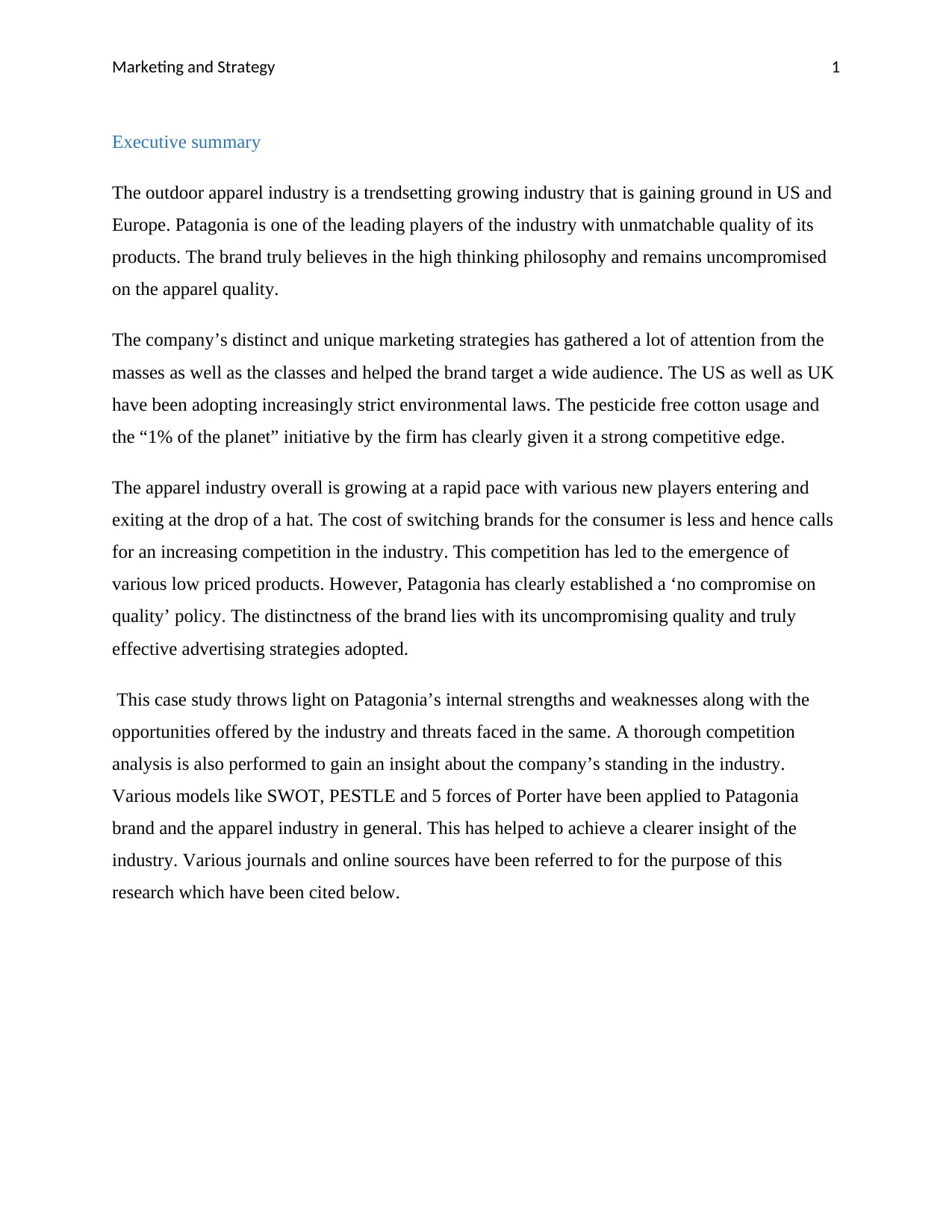
Marketing and Strategy 1
Executive summary
The outdoor apparel industry is a trendsetting growing industry that is gaining ground in US and
Europe. Patagonia is one of the leading players of the industry with unmatchable quality of its
products. The brand truly believes in the high thinking philosophy and remains uncompromised
on the apparel quality.
The company’s distinct and unique marketing strategies has gathered a lot of attention from the
masses as well as the classes and helped the brand target a wide audience. The US as well as UK
have been adopting increasingly strict environmental laws. The pesticide free cotton usage and
the “1% of the planet” initiative by the firm has clearly given it a strong competitive edge.
The apparel industry overall is growing at a rapid pace with various new players entering and
exiting at the drop of a hat. The cost of switching brands for the consumer is less and hence calls
for an increasing competition in the industry. This competition has led to the emergence of
various low priced products. However, Patagonia has clearly established a ‘no compromise on
quality’ policy. The distinctness of the brand lies with its uncompromising quality and truly
effective advertising strategies adopted.
This case study throws light on Patagonia’s internal strengths and weaknesses along with the
opportunities offered by the industry and threats faced in the same. A thorough competition
analysis is also performed to gain an insight about the company’s standing in the industry.
Various models like SWOT, PESTLE and 5 forces of Porter have been applied to Patagonia
brand and the apparel industry in general. This has helped to achieve a clearer insight of the
industry. Various journals and online sources have been referred to for the purpose of this
research which have been cited below.
Executive summary
The outdoor apparel industry is a trendsetting growing industry that is gaining ground in US and
Europe. Patagonia is one of the leading players of the industry with unmatchable quality of its
products. The brand truly believes in the high thinking philosophy and remains uncompromised
on the apparel quality.
The company’s distinct and unique marketing strategies has gathered a lot of attention from the
masses as well as the classes and helped the brand target a wide audience. The US as well as UK
have been adopting increasingly strict environmental laws. The pesticide free cotton usage and
the “1% of the planet” initiative by the firm has clearly given it a strong competitive edge.
The apparel industry overall is growing at a rapid pace with various new players entering and
exiting at the drop of a hat. The cost of switching brands for the consumer is less and hence calls
for an increasing competition in the industry. This competition has led to the emergence of
various low priced products. However, Patagonia has clearly established a ‘no compromise on
quality’ policy. The distinctness of the brand lies with its uncompromising quality and truly
effective advertising strategies adopted.
This case study throws light on Patagonia’s internal strengths and weaknesses along with the
opportunities offered by the industry and threats faced in the same. A thorough competition
analysis is also performed to gain an insight about the company’s standing in the industry.
Various models like SWOT, PESTLE and 5 forces of Porter have been applied to Patagonia
brand and the apparel industry in general. This has helped to achieve a clearer insight of the
industry. Various journals and online sources have been referred to for the purpose of this
research which have been cited below.
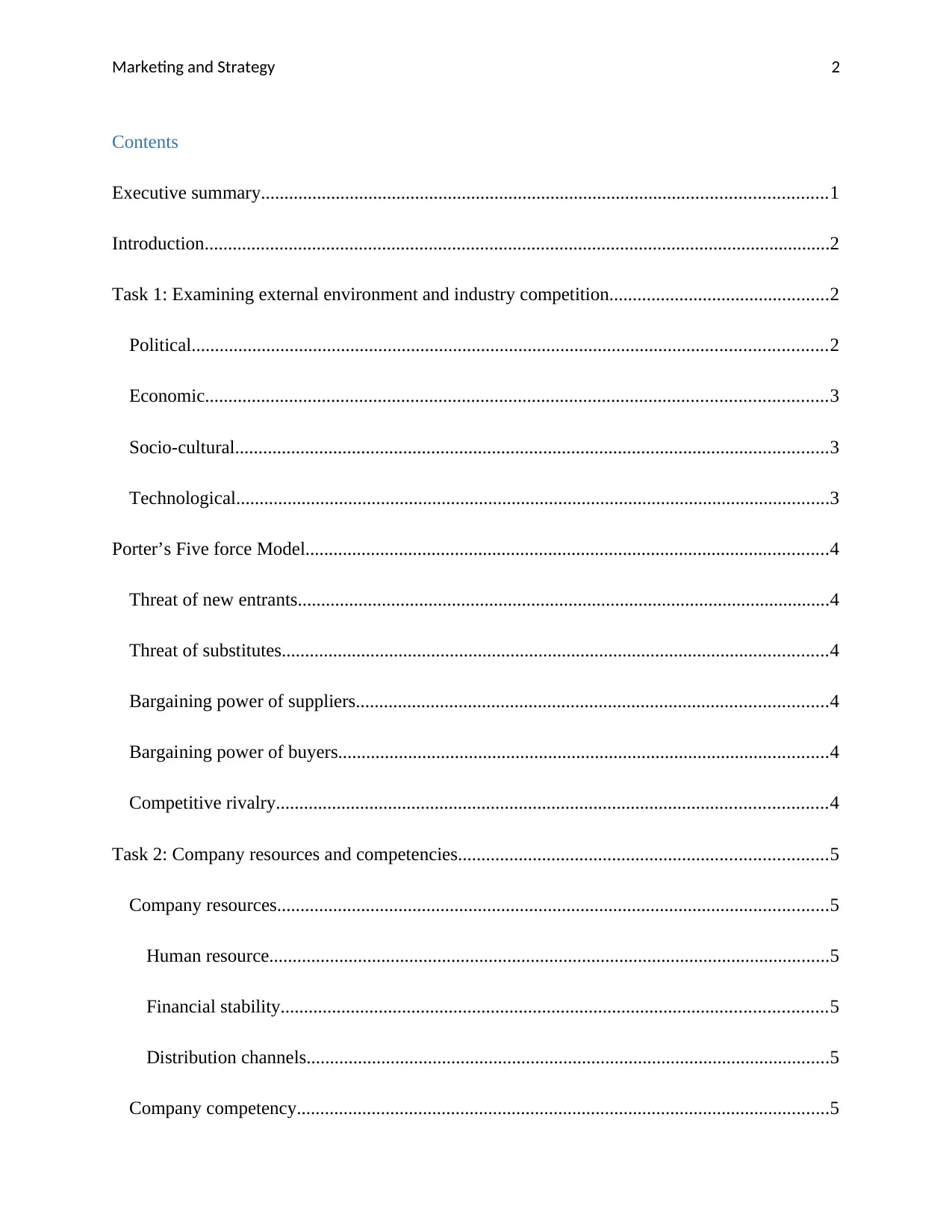
Marketing and Strategy 2
Contents
Executive summary.........................................................................................................................1
Introduction......................................................................................................................................2
Task 1: Examining external environment and industry competition...............................................2
Political........................................................................................................................................2
Economic.....................................................................................................................................3
Socio-cultural...............................................................................................................................3
Technological...............................................................................................................................3
Porter’s Five force Model................................................................................................................4
Threat of new entrants..................................................................................................................4
Threat of substitutes.....................................................................................................................4
Bargaining power of suppliers.....................................................................................................4
Bargaining power of buyers.........................................................................................................4
Competitive rivalry......................................................................................................................4
Task 2: Company resources and competencies...............................................................................5
Company resources......................................................................................................................5
Human resource........................................................................................................................5
Financial stability.....................................................................................................................5
Distribution channels................................................................................................................5
Company competency..................................................................................................................5
Contents
Executive summary.........................................................................................................................1
Introduction......................................................................................................................................2
Task 1: Examining external environment and industry competition...............................................2
Political........................................................................................................................................2
Economic.....................................................................................................................................3
Socio-cultural...............................................................................................................................3
Technological...............................................................................................................................3
Porter’s Five force Model................................................................................................................4
Threat of new entrants..................................................................................................................4
Threat of substitutes.....................................................................................................................4
Bargaining power of suppliers.....................................................................................................4
Bargaining power of buyers.........................................................................................................4
Competitive rivalry......................................................................................................................4
Task 2: Company resources and competencies...............................................................................5
Company resources......................................................................................................................5
Human resource........................................................................................................................5
Financial stability.....................................................................................................................5
Distribution channels................................................................................................................5
Company competency..................................................................................................................5
⊘ This is a preview!⊘
Do you want full access?
Subscribe today to unlock all pages.

Trusted by 1+ million students worldwide

Marketing and Strategy 3
Quality of products...................................................................................................................6
Innovation in design.................................................................................................................6
Organizational culture..............................................................................................................6
Environment friendly approach................................................................................................6
Marketing strategies.................................................................................................................6
Unique selling...........................................................................................................................7
Task 3: Mission statement...............................................................................................................7
Task 4: SWOT analysis...................................................................................................................8
Strengths.......................................................................................................................................8
Weaknesses..................................................................................................................................8
Opportunities................................................................................................................................9
Threats..........................................................................................................................................9
Referencing......................................................................................................................................9
Appendices....................................................................................................................................11
Quality of products...................................................................................................................6
Innovation in design.................................................................................................................6
Organizational culture..............................................................................................................6
Environment friendly approach................................................................................................6
Marketing strategies.................................................................................................................6
Unique selling...........................................................................................................................7
Task 3: Mission statement...............................................................................................................7
Task 4: SWOT analysis...................................................................................................................8
Strengths.......................................................................................................................................8
Weaknesses..................................................................................................................................8
Opportunities................................................................................................................................9
Threats..........................................................................................................................................9
Referencing......................................................................................................................................9
Appendices....................................................................................................................................11
Paraphrase This Document
Need a fresh take? Get an instant paraphrase of this document with our AI Paraphraser
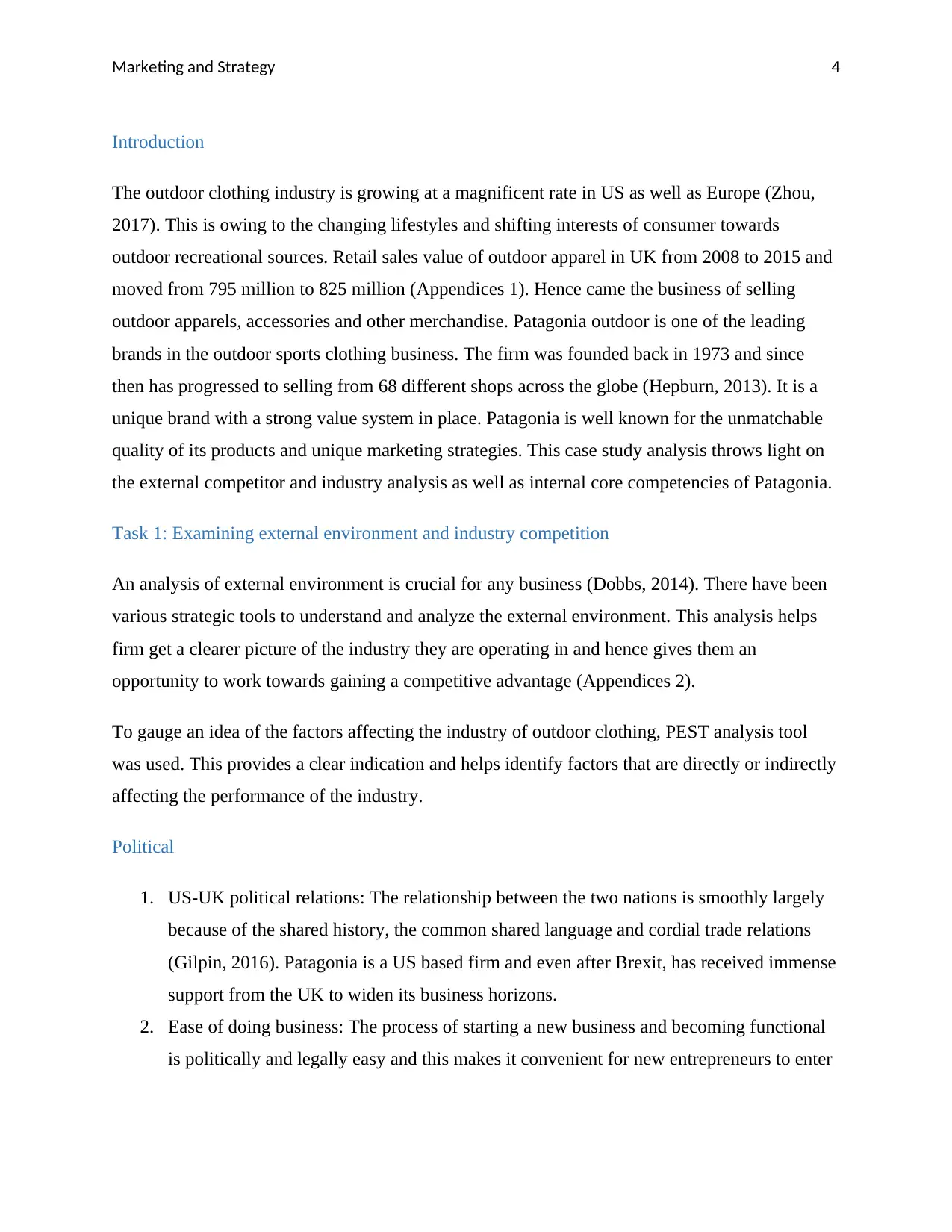
Marketing and Strategy 4
Introduction
The outdoor clothing industry is growing at a magnificent rate in US as well as Europe (Zhou,
2017). This is owing to the changing lifestyles and shifting interests of consumer towards
outdoor recreational sources. Retail sales value of outdoor apparel in UK from 2008 to 2015 and
moved from 795 million to 825 million (Appendices 1). Hence came the business of selling
outdoor apparels, accessories and other merchandise. Patagonia outdoor is one of the leading
brands in the outdoor sports clothing business. The firm was founded back in 1973 and since
then has progressed to selling from 68 different shops across the globe (Hepburn, 2013). It is a
unique brand with a strong value system in place. Patagonia is well known for the unmatchable
quality of its products and unique marketing strategies. This case study analysis throws light on
the external competitor and industry analysis as well as internal core competencies of Patagonia.
Task 1: Examining external environment and industry competition
An analysis of external environment is crucial for any business (Dobbs, 2014). There have been
various strategic tools to understand and analyze the external environment. This analysis helps
firm get a clearer picture of the industry they are operating in and hence gives them an
opportunity to work towards gaining a competitive advantage (Appendices 2).
To gauge an idea of the factors affecting the industry of outdoor clothing, PEST analysis tool
was used. This provides a clear indication and helps identify factors that are directly or indirectly
affecting the performance of the industry.
Political
1. US-UK political relations: The relationship between the two nations is smoothly largely
because of the shared history, the common shared language and cordial trade relations
(Gilpin, 2016). Patagonia is a US based firm and even after Brexit, has received immense
support from the UK to widen its business horizons.
2. Ease of doing business: The process of starting a new business and becoming functional
is politically and legally easy and this makes it convenient for new entrepreneurs to enter
Introduction
The outdoor clothing industry is growing at a magnificent rate in US as well as Europe (Zhou,
2017). This is owing to the changing lifestyles and shifting interests of consumer towards
outdoor recreational sources. Retail sales value of outdoor apparel in UK from 2008 to 2015 and
moved from 795 million to 825 million (Appendices 1). Hence came the business of selling
outdoor apparels, accessories and other merchandise. Patagonia outdoor is one of the leading
brands in the outdoor sports clothing business. The firm was founded back in 1973 and since
then has progressed to selling from 68 different shops across the globe (Hepburn, 2013). It is a
unique brand with a strong value system in place. Patagonia is well known for the unmatchable
quality of its products and unique marketing strategies. This case study analysis throws light on
the external competitor and industry analysis as well as internal core competencies of Patagonia.
Task 1: Examining external environment and industry competition
An analysis of external environment is crucial for any business (Dobbs, 2014). There have been
various strategic tools to understand and analyze the external environment. This analysis helps
firm get a clearer picture of the industry they are operating in and hence gives them an
opportunity to work towards gaining a competitive advantage (Appendices 2).
To gauge an idea of the factors affecting the industry of outdoor clothing, PEST analysis tool
was used. This provides a clear indication and helps identify factors that are directly or indirectly
affecting the performance of the industry.
Political
1. US-UK political relations: The relationship between the two nations is smoothly largely
because of the shared history, the common shared language and cordial trade relations
(Gilpin, 2016). Patagonia is a US based firm and even after Brexit, has received immense
support from the UK to widen its business horizons.
2. Ease of doing business: The process of starting a new business and becoming functional
is politically and legally easy and this makes it convenient for new entrepreneurs to enter
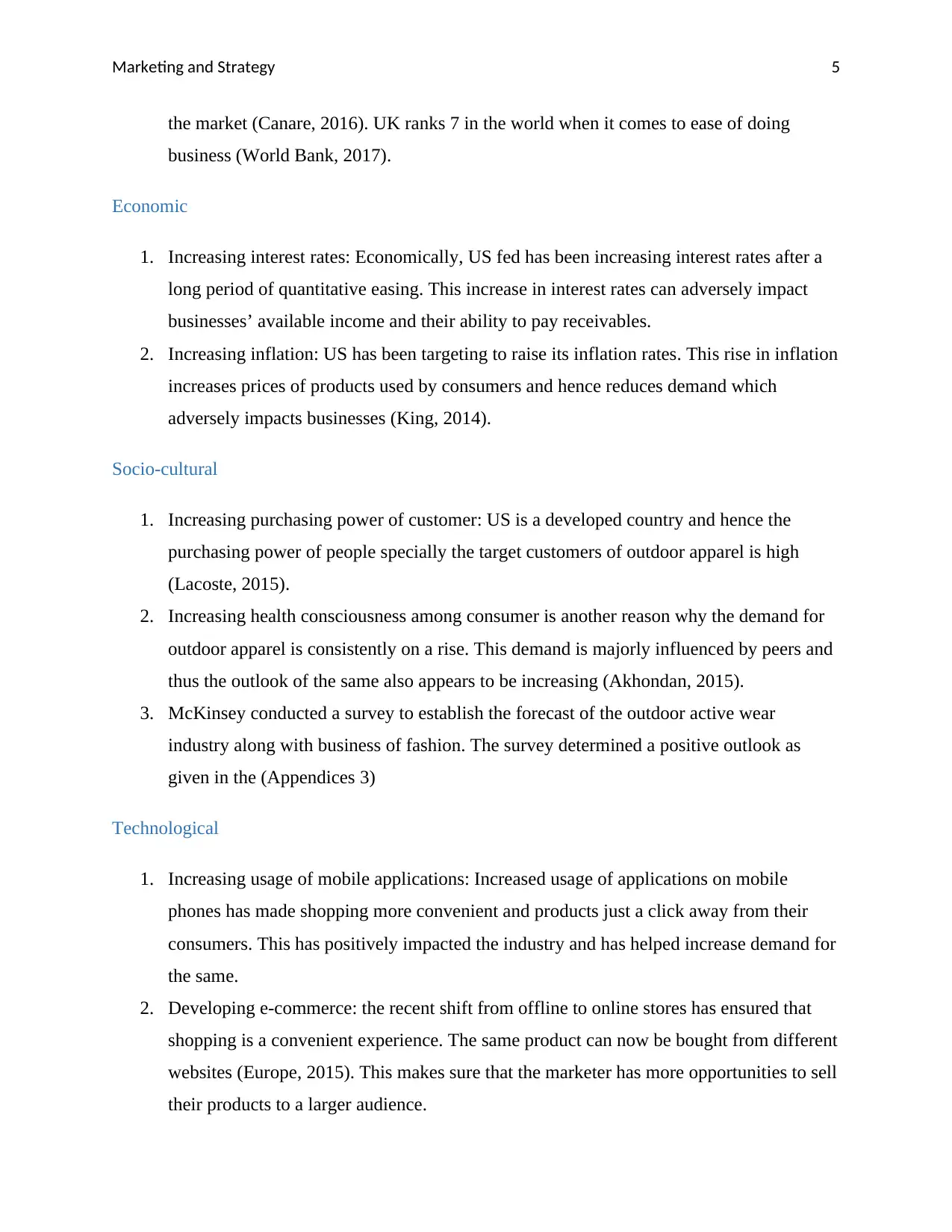
Marketing and Strategy 5
the market (Canare, 2016). UK ranks 7 in the world when it comes to ease of doing
business (World Bank, 2017).
Economic
1. Increasing interest rates: Economically, US fed has been increasing interest rates after a
long period of quantitative easing. This increase in interest rates can adversely impact
businesses’ available income and their ability to pay receivables.
2. Increasing inflation: US has been targeting to raise its inflation rates. This rise in inflation
increases prices of products used by consumers and hence reduces demand which
adversely impacts businesses (King, 2014).
Socio-cultural
1. Increasing purchasing power of customer: US is a developed country and hence the
purchasing power of people specially the target customers of outdoor apparel is high
(Lacoste, 2015).
2. Increasing health consciousness among consumer is another reason why the demand for
outdoor apparel is consistently on a rise. This demand is majorly influenced by peers and
thus the outlook of the same also appears to be increasing (Akhondan, 2015).
3. McKinsey conducted a survey to establish the forecast of the outdoor active wear
industry along with business of fashion. The survey determined a positive outlook as
given in the (Appendices 3)
Technological
1. Increasing usage of mobile applications: Increased usage of applications on mobile
phones has made shopping more convenient and products just a click away from their
consumers. This has positively impacted the industry and has helped increase demand for
the same.
2. Developing e-commerce: the recent shift from offline to online stores has ensured that
shopping is a convenient experience. The same product can now be bought from different
websites (Europe, 2015). This makes sure that the marketer has more opportunities to sell
their products to a larger audience.
the market (Canare, 2016). UK ranks 7 in the world when it comes to ease of doing
business (World Bank, 2017).
Economic
1. Increasing interest rates: Economically, US fed has been increasing interest rates after a
long period of quantitative easing. This increase in interest rates can adversely impact
businesses’ available income and their ability to pay receivables.
2. Increasing inflation: US has been targeting to raise its inflation rates. This rise in inflation
increases prices of products used by consumers and hence reduces demand which
adversely impacts businesses (King, 2014).
Socio-cultural
1. Increasing purchasing power of customer: US is a developed country and hence the
purchasing power of people specially the target customers of outdoor apparel is high
(Lacoste, 2015).
2. Increasing health consciousness among consumer is another reason why the demand for
outdoor apparel is consistently on a rise. This demand is majorly influenced by peers and
thus the outlook of the same also appears to be increasing (Akhondan, 2015).
3. McKinsey conducted a survey to establish the forecast of the outdoor active wear
industry along with business of fashion. The survey determined a positive outlook as
given in the (Appendices 3)
Technological
1. Increasing usage of mobile applications: Increased usage of applications on mobile
phones has made shopping more convenient and products just a click away from their
consumers. This has positively impacted the industry and has helped increase demand for
the same.
2. Developing e-commerce: the recent shift from offline to online stores has ensured that
shopping is a convenient experience. The same product can now be bought from different
websites (Europe, 2015). This makes sure that the marketer has more opportunities to sell
their products to a larger audience.
⊘ This is a preview!⊘
Do you want full access?
Subscribe today to unlock all pages.

Trusted by 1+ million students worldwide
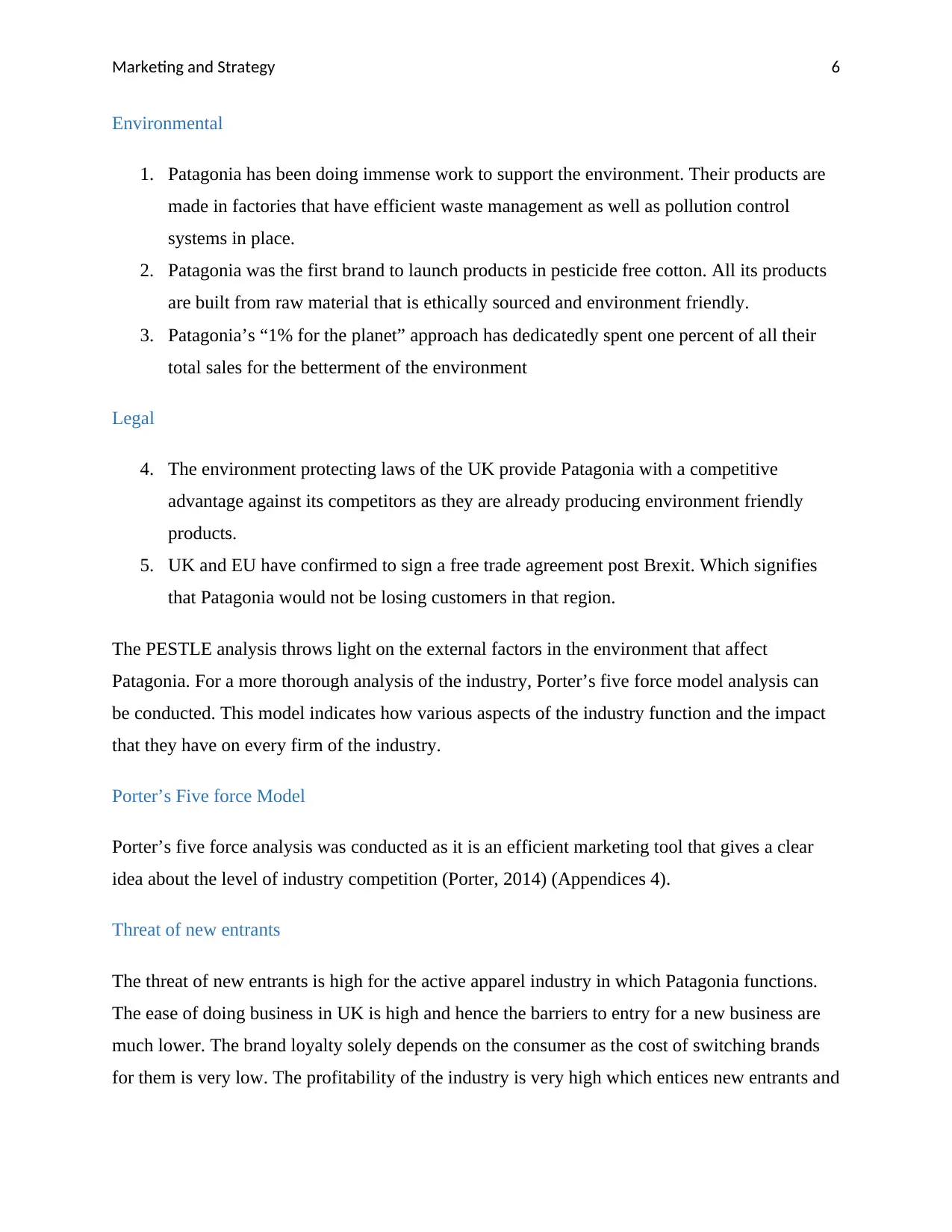
Marketing and Strategy 6
Environmental
1. Patagonia has been doing immense work to support the environment. Their products are
made in factories that have efficient waste management as well as pollution control
systems in place.
2. Patagonia was the first brand to launch products in pesticide free cotton. All its products
are built from raw material that is ethically sourced and environment friendly.
3. Patagonia’s “1% for the planet” approach has dedicatedly spent one percent of all their
total sales for the betterment of the environment
Legal
4. The environment protecting laws of the UK provide Patagonia with a competitive
advantage against its competitors as they are already producing environment friendly
products.
5. UK and EU have confirmed to sign a free trade agreement post Brexit. Which signifies
that Patagonia would not be losing customers in that region.
The PESTLE analysis throws light on the external factors in the environment that affect
Patagonia. For a more thorough analysis of the industry, Porter’s five force model analysis can
be conducted. This model indicates how various aspects of the industry function and the impact
that they have on every firm of the industry.
Porter’s Five force Model
Porter’s five force analysis was conducted as it is an efficient marketing tool that gives a clear
idea about the level of industry competition (Porter, 2014) (Appendices 4).
Threat of new entrants
The threat of new entrants is high for the active apparel industry in which Patagonia functions.
The ease of doing business in UK is high and hence the barriers to entry for a new business are
much lower. The brand loyalty solely depends on the consumer as the cost of switching brands
for them is very low. The profitability of the industry is very high which entices new entrants and
Environmental
1. Patagonia has been doing immense work to support the environment. Their products are
made in factories that have efficient waste management as well as pollution control
systems in place.
2. Patagonia was the first brand to launch products in pesticide free cotton. All its products
are built from raw material that is ethically sourced and environment friendly.
3. Patagonia’s “1% for the planet” approach has dedicatedly spent one percent of all their
total sales for the betterment of the environment
Legal
4. The environment protecting laws of the UK provide Patagonia with a competitive
advantage against its competitors as they are already producing environment friendly
products.
5. UK and EU have confirmed to sign a free trade agreement post Brexit. Which signifies
that Patagonia would not be losing customers in that region.
The PESTLE analysis throws light on the external factors in the environment that affect
Patagonia. For a more thorough analysis of the industry, Porter’s five force model analysis can
be conducted. This model indicates how various aspects of the industry function and the impact
that they have on every firm of the industry.
Porter’s Five force Model
Porter’s five force analysis was conducted as it is an efficient marketing tool that gives a clear
idea about the level of industry competition (Porter, 2014) (Appendices 4).
Threat of new entrants
The threat of new entrants is high for the active apparel industry in which Patagonia functions.
The ease of doing business in UK is high and hence the barriers to entry for a new business are
much lower. The brand loyalty solely depends on the consumer as the cost of switching brands
for them is very low. The profitability of the industry is very high which entices new entrants and
Paraphrase This Document
Need a fresh take? Get an instant paraphrase of this document with our AI Paraphraser
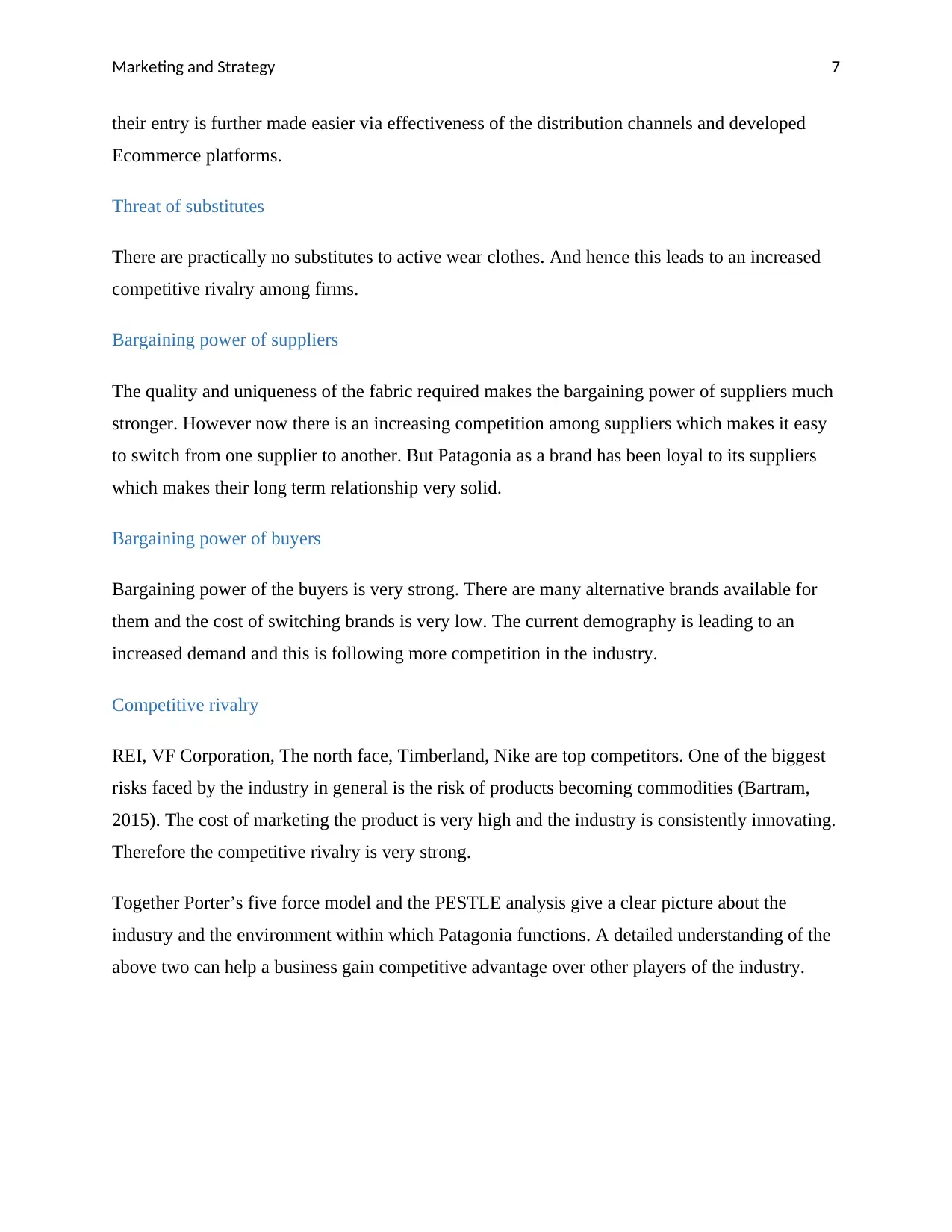
Marketing and Strategy 7
their entry is further made easier via effectiveness of the distribution channels and developed
Ecommerce platforms.
Threat of substitutes
There are practically no substitutes to active wear clothes. And hence this leads to an increased
competitive rivalry among firms.
Bargaining power of suppliers
The quality and uniqueness of the fabric required makes the bargaining power of suppliers much
stronger. However now there is an increasing competition among suppliers which makes it easy
to switch from one supplier to another. But Patagonia as a brand has been loyal to its suppliers
which makes their long term relationship very solid.
Bargaining power of buyers
Bargaining power of the buyers is very strong. There are many alternative brands available for
them and the cost of switching brands is very low. The current demography is leading to an
increased demand and this is following more competition in the industry.
Competitive rivalry
REI, VF Corporation, The north face, Timberland, Nike are top competitors. One of the biggest
risks faced by the industry in general is the risk of products becoming commodities (Bartram,
2015). The cost of marketing the product is very high and the industry is consistently innovating.
Therefore the competitive rivalry is very strong.
Together Porter’s five force model and the PESTLE analysis give a clear picture about the
industry and the environment within which Patagonia functions. A detailed understanding of the
above two can help a business gain competitive advantage over other players of the industry.
their entry is further made easier via effectiveness of the distribution channels and developed
Ecommerce platforms.
Threat of substitutes
There are practically no substitutes to active wear clothes. And hence this leads to an increased
competitive rivalry among firms.
Bargaining power of suppliers
The quality and uniqueness of the fabric required makes the bargaining power of suppliers much
stronger. However now there is an increasing competition among suppliers which makes it easy
to switch from one supplier to another. But Patagonia as a brand has been loyal to its suppliers
which makes their long term relationship very solid.
Bargaining power of buyers
Bargaining power of the buyers is very strong. There are many alternative brands available for
them and the cost of switching brands is very low. The current demography is leading to an
increased demand and this is following more competition in the industry.
Competitive rivalry
REI, VF Corporation, The north face, Timberland, Nike are top competitors. One of the biggest
risks faced by the industry in general is the risk of products becoming commodities (Bartram,
2015). The cost of marketing the product is very high and the industry is consistently innovating.
Therefore the competitive rivalry is very strong.
Together Porter’s five force model and the PESTLE analysis give a clear picture about the
industry and the environment within which Patagonia functions. A detailed understanding of the
above two can help a business gain competitive advantage over other players of the industry.
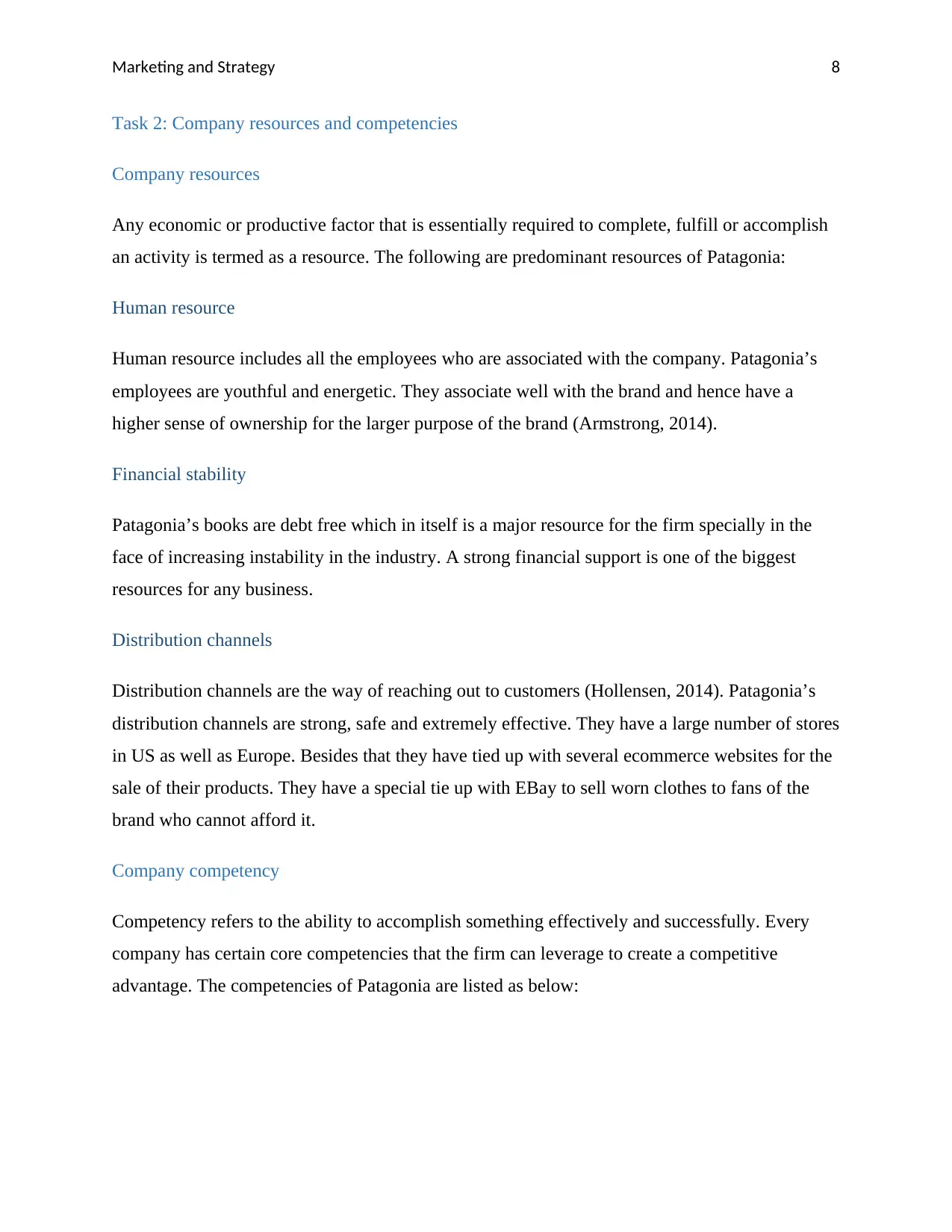
Marketing and Strategy 8
Task 2: Company resources and competencies
Company resources
Any economic or productive factor that is essentially required to complete, fulfill or accomplish
an activity is termed as a resource. The following are predominant resources of Patagonia:
Human resource
Human resource includes all the employees who are associated with the company. Patagonia’s
employees are youthful and energetic. They associate well with the brand and hence have a
higher sense of ownership for the larger purpose of the brand (Armstrong, 2014).
Financial stability
Patagonia’s books are debt free which in itself is a major resource for the firm specially in the
face of increasing instability in the industry. A strong financial support is one of the biggest
resources for any business.
Distribution channels
Distribution channels are the way of reaching out to customers (Hollensen, 2014). Patagonia’s
distribution channels are strong, safe and extremely effective. They have a large number of stores
in US as well as Europe. Besides that they have tied up with several ecommerce websites for the
sale of their products. They have a special tie up with EBay to sell worn clothes to fans of the
brand who cannot afford it.
Company competency
Competency refers to the ability to accomplish something effectively and successfully. Every
company has certain core competencies that the firm can leverage to create a competitive
advantage. The competencies of Patagonia are listed as below:
Task 2: Company resources and competencies
Company resources
Any economic or productive factor that is essentially required to complete, fulfill or accomplish
an activity is termed as a resource. The following are predominant resources of Patagonia:
Human resource
Human resource includes all the employees who are associated with the company. Patagonia’s
employees are youthful and energetic. They associate well with the brand and hence have a
higher sense of ownership for the larger purpose of the brand (Armstrong, 2014).
Financial stability
Patagonia’s books are debt free which in itself is a major resource for the firm specially in the
face of increasing instability in the industry. A strong financial support is one of the biggest
resources for any business.
Distribution channels
Distribution channels are the way of reaching out to customers (Hollensen, 2014). Patagonia’s
distribution channels are strong, safe and extremely effective. They have a large number of stores
in US as well as Europe. Besides that they have tied up with several ecommerce websites for the
sale of their products. They have a special tie up with EBay to sell worn clothes to fans of the
brand who cannot afford it.
Company competency
Competency refers to the ability to accomplish something effectively and successfully. Every
company has certain core competencies that the firm can leverage to create a competitive
advantage. The competencies of Patagonia are listed as below:
⊘ This is a preview!⊘
Do you want full access?
Subscribe today to unlock all pages.

Trusted by 1+ million students worldwide

Marketing and Strategy 9
Quality of products
Patagonia is extremely strict about the quality of apparel it sells to its consumers. In order to
protect the environment. Patagonia was the first brand to launch products in pesticide free cotton.
All its products are built from raw material that is ethically sourced and environment friendly.
The consumers of the brands find it difficult to switch to another brand owing to the unmatchable
quality of Patagonia’s products.
Innovation in design
Patagonia consistently strives to make innovative and unique designs for their merchandises.
They have a dedicated team that solely researches on upcoming trends and designs. This ensures
a consistent interest in the brand by offering something new to consumers.
Organizational culture
Patagonia has a young and enthusiastic culture which is full of energy. Their organizational
structure is flat and hence provides employees a chance to foster their creativity and innovation.
Environment friendly approach
The environmental friendly approach of Patagonia is one of its biggest competency. Patagonia’s
“1% of the planet” initiative mas made the brand pledge 1% of their total sales to the
environment by contributing it to agencies and organizations that work for the restoration and
preservation of environment (Patagonia, 2017).
Marketing strategies
Innovating marketing strategies implemented by Patagonia have always grabbed the consumers’
attention. On the eve of black Friday, the newspapers carried a page long picture of “Do you
need this jacket”, indicating users to ponder over their shopping expenses and refrain from
buying unnecessary things. This was a one of kind marketing initiative that garnered huge
response and respect from the consumers.
Quality of products
Patagonia is extremely strict about the quality of apparel it sells to its consumers. In order to
protect the environment. Patagonia was the first brand to launch products in pesticide free cotton.
All its products are built from raw material that is ethically sourced and environment friendly.
The consumers of the brands find it difficult to switch to another brand owing to the unmatchable
quality of Patagonia’s products.
Innovation in design
Patagonia consistently strives to make innovative and unique designs for their merchandises.
They have a dedicated team that solely researches on upcoming trends and designs. This ensures
a consistent interest in the brand by offering something new to consumers.
Organizational culture
Patagonia has a young and enthusiastic culture which is full of energy. Their organizational
structure is flat and hence provides employees a chance to foster their creativity and innovation.
Environment friendly approach
The environmental friendly approach of Patagonia is one of its biggest competency. Patagonia’s
“1% of the planet” initiative mas made the brand pledge 1% of their total sales to the
environment by contributing it to agencies and organizations that work for the restoration and
preservation of environment (Patagonia, 2017).
Marketing strategies
Innovating marketing strategies implemented by Patagonia have always grabbed the consumers’
attention. On the eve of black Friday, the newspapers carried a page long picture of “Do you
need this jacket”, indicating users to ponder over their shopping expenses and refrain from
buying unnecessary things. This was a one of kind marketing initiative that garnered huge
response and respect from the consumers.
Paraphrase This Document
Need a fresh take? Get an instant paraphrase of this document with our AI Paraphraser
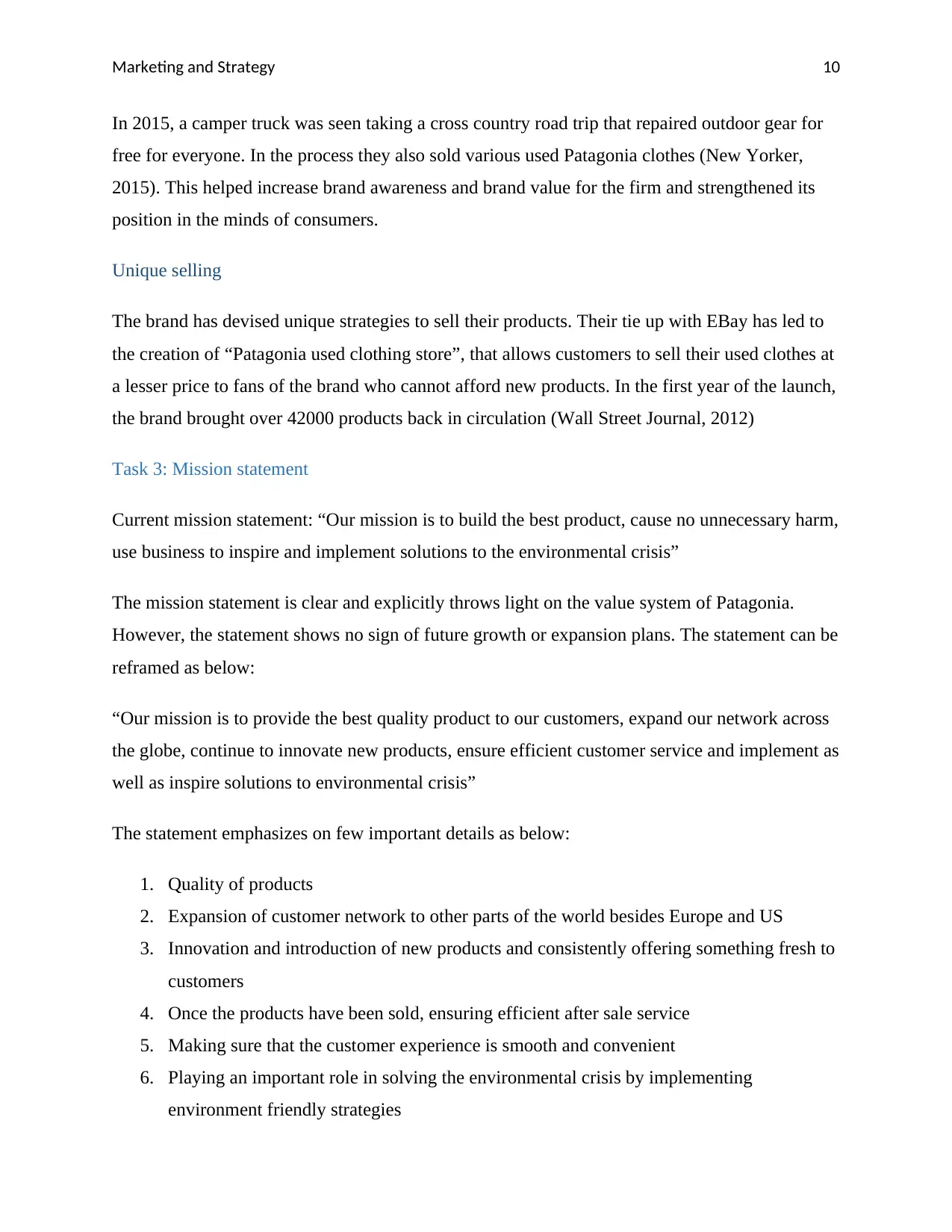
Marketing and Strategy 10
In 2015, a camper truck was seen taking a cross country road trip that repaired outdoor gear for
free for everyone. In the process they also sold various used Patagonia clothes (New Yorker,
2015). This helped increase brand awareness and brand value for the firm and strengthened its
position in the minds of consumers.
Unique selling
The brand has devised unique strategies to sell their products. Their tie up with EBay has led to
the creation of “Patagonia used clothing store”, that allows customers to sell their used clothes at
a lesser price to fans of the brand who cannot afford new products. In the first year of the launch,
the brand brought over 42000 products back in circulation (Wall Street Journal, 2012)
Task 3: Mission statement
Current mission statement: “Our mission is to build the best product, cause no unnecessary harm,
use business to inspire and implement solutions to the environmental crisis”
The mission statement is clear and explicitly throws light on the value system of Patagonia.
However, the statement shows no sign of future growth or expansion plans. The statement can be
reframed as below:
“Our mission is to provide the best quality product to our customers, expand our network across
the globe, continue to innovate new products, ensure efficient customer service and implement as
well as inspire solutions to environmental crisis”
The statement emphasizes on few important details as below:
1. Quality of products
2. Expansion of customer network to other parts of the world besides Europe and US
3. Innovation and introduction of new products and consistently offering something fresh to
customers
4. Once the products have been sold, ensuring efficient after sale service
5. Making sure that the customer experience is smooth and convenient
6. Playing an important role in solving the environmental crisis by implementing
environment friendly strategies
In 2015, a camper truck was seen taking a cross country road trip that repaired outdoor gear for
free for everyone. In the process they also sold various used Patagonia clothes (New Yorker,
2015). This helped increase brand awareness and brand value for the firm and strengthened its
position in the minds of consumers.
Unique selling
The brand has devised unique strategies to sell their products. Their tie up with EBay has led to
the creation of “Patagonia used clothing store”, that allows customers to sell their used clothes at
a lesser price to fans of the brand who cannot afford new products. In the first year of the launch,
the brand brought over 42000 products back in circulation (Wall Street Journal, 2012)
Task 3: Mission statement
Current mission statement: “Our mission is to build the best product, cause no unnecessary harm,
use business to inspire and implement solutions to the environmental crisis”
The mission statement is clear and explicitly throws light on the value system of Patagonia.
However, the statement shows no sign of future growth or expansion plans. The statement can be
reframed as below:
“Our mission is to provide the best quality product to our customers, expand our network across
the globe, continue to innovate new products, ensure efficient customer service and implement as
well as inspire solutions to environmental crisis”
The statement emphasizes on few important details as below:
1. Quality of products
2. Expansion of customer network to other parts of the world besides Europe and US
3. Innovation and introduction of new products and consistently offering something fresh to
customers
4. Once the products have been sold, ensuring efficient after sale service
5. Making sure that the customer experience is smooth and convenient
6. Playing an important role in solving the environmental crisis by implementing
environment friendly strategies
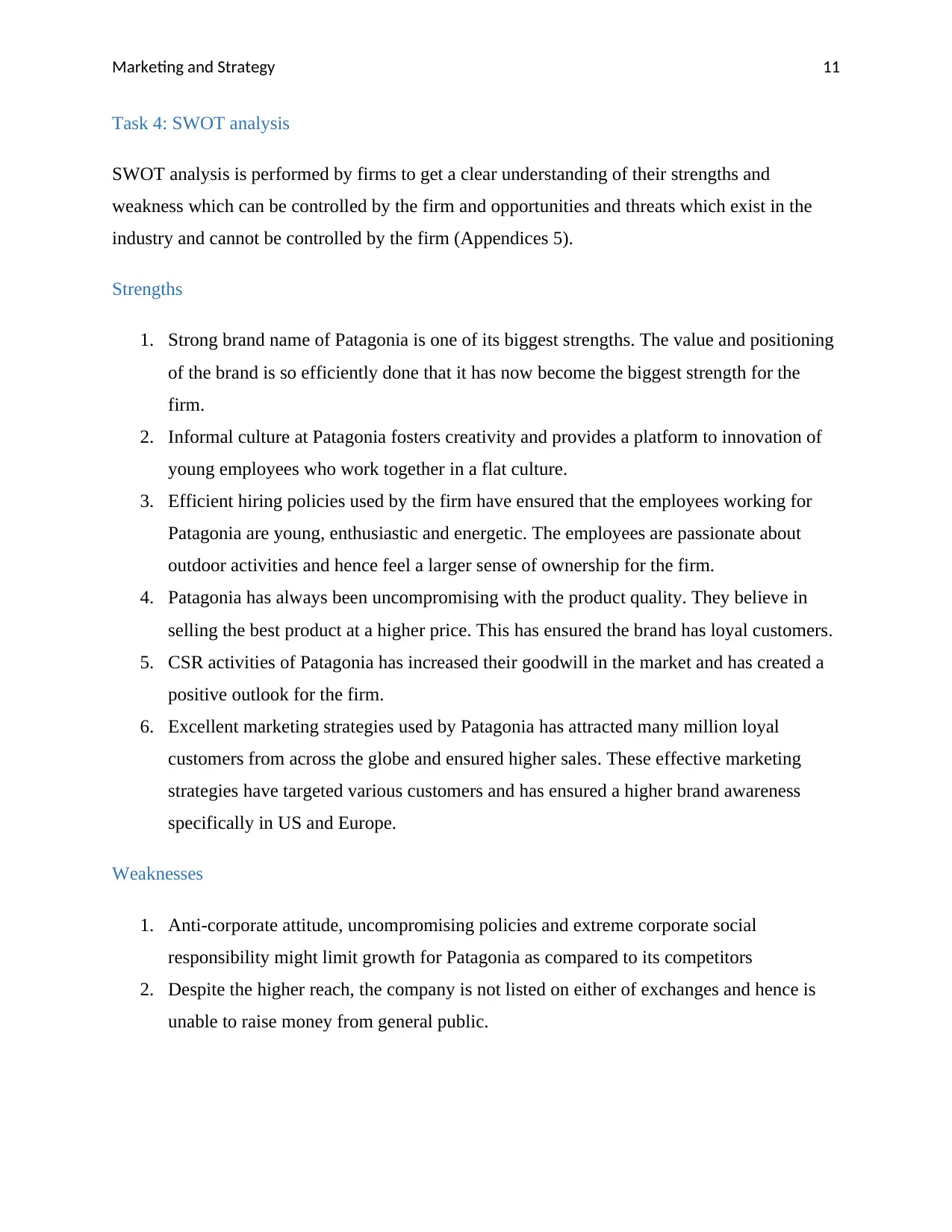
Marketing and Strategy 11
Task 4: SWOT analysis
SWOT analysis is performed by firms to get a clear understanding of their strengths and
weakness which can be controlled by the firm and opportunities and threats which exist in the
industry and cannot be controlled by the firm (Appendices 5).
Strengths
1. Strong brand name of Patagonia is one of its biggest strengths. The value and positioning
of the brand is so efficiently done that it has now become the biggest strength for the
firm.
2. Informal culture at Patagonia fosters creativity and provides a platform to innovation of
young employees who work together in a flat culture.
3. Efficient hiring policies used by the firm have ensured that the employees working for
Patagonia are young, enthusiastic and energetic. The employees are passionate about
outdoor activities and hence feel a larger sense of ownership for the firm.
4. Patagonia has always been uncompromising with the product quality. They believe in
selling the best product at a higher price. This has ensured the brand has loyal customers.
5. CSR activities of Patagonia has increased their goodwill in the market and has created a
positive outlook for the firm.
6. Excellent marketing strategies used by Patagonia has attracted many million loyal
customers from across the globe and ensured higher sales. These effective marketing
strategies have targeted various customers and has ensured a higher brand awareness
specifically in US and Europe.
Weaknesses
1. Anti-corporate attitude, uncompromising policies and extreme corporate social
responsibility might limit growth for Patagonia as compared to its competitors
2. Despite the higher reach, the company is not listed on either of exchanges and hence is
unable to raise money from general public.
Task 4: SWOT analysis
SWOT analysis is performed by firms to get a clear understanding of their strengths and
weakness which can be controlled by the firm and opportunities and threats which exist in the
industry and cannot be controlled by the firm (Appendices 5).
Strengths
1. Strong brand name of Patagonia is one of its biggest strengths. The value and positioning
of the brand is so efficiently done that it has now become the biggest strength for the
firm.
2. Informal culture at Patagonia fosters creativity and provides a platform to innovation of
young employees who work together in a flat culture.
3. Efficient hiring policies used by the firm have ensured that the employees working for
Patagonia are young, enthusiastic and energetic. The employees are passionate about
outdoor activities and hence feel a larger sense of ownership for the firm.
4. Patagonia has always been uncompromising with the product quality. They believe in
selling the best product at a higher price. This has ensured the brand has loyal customers.
5. CSR activities of Patagonia has increased their goodwill in the market and has created a
positive outlook for the firm.
6. Excellent marketing strategies used by Patagonia has attracted many million loyal
customers from across the globe and ensured higher sales. These effective marketing
strategies have targeted various customers and has ensured a higher brand awareness
specifically in US and Europe.
Weaknesses
1. Anti-corporate attitude, uncompromising policies and extreme corporate social
responsibility might limit growth for Patagonia as compared to its competitors
2. Despite the higher reach, the company is not listed on either of exchanges and hence is
unable to raise money from general public.
⊘ This is a preview!⊘
Do you want full access?
Subscribe today to unlock all pages.

Trusted by 1+ million students worldwide
1 out of 19
Related Documents
Your All-in-One AI-Powered Toolkit for Academic Success.
+13062052269
info@desklib.com
Available 24*7 on WhatsApp / Email
![[object Object]](/_next/static/media/star-bottom.7253800d.svg)
Unlock your academic potential
Copyright © 2020–2026 A2Z Services. All Rights Reserved. Developed and managed by ZUCOL.





